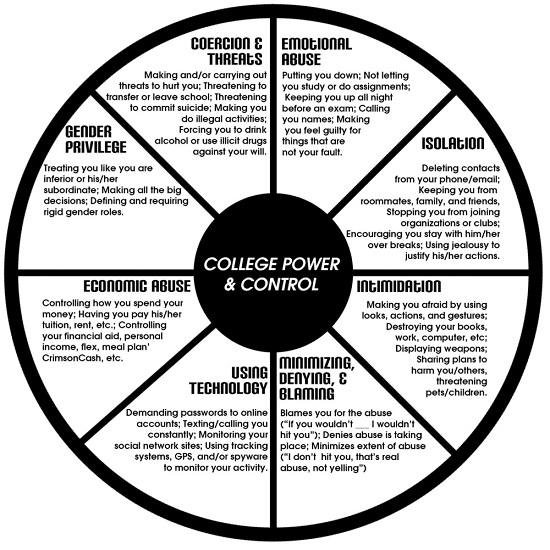Know the Facts
According to the National Coalition Against Domestic Violence (NCADV):
- One in four women and one in seven men will experience domestic violence in their lifetime.
- Females who are 20-24 years of age are at the greatest risk of nonfatal intimate partner violence.
- Domestic violence is the number one reason women go to the ER in the United States.
- Every 15 seconds, a woman is physically abused by her partner.
What is Domestic Violence?
Domestic violence is the willful intimidation, physical assault, battery, sexual assault, and/or other abusive behavior as part of a systematic pattern of power and control perpetrated by one intimate partner against another. It includes physical violence sexual violence, psychological violence, and emotional abuse. The frequency and severity of domestic violence can vary dramatically; however, the one constant component of domestic violence is one partner's consistent efforts to maintain power and control over the other. NCADV
What is Dating Violence?
Dating violence is violence committed by a person who is or has been in a social relationship of a romantic or intimate nature with the victim is dating violence. The existence of such a relationship shall be determined based on a consideration of the following factors:
- the length of the relationship
- the type of relationship
- the frequency of interaction between the persons involved in the relationship (USDOJ)
Student Conduct Policy
As a community, the university has developed a code of standards and expectations that are consistent with its purpose as an educational institution. The Student Conduct Policies and Procedures articulate these standards. Students are held accountable for violations of these policies through the university conduct system.
Information about domestic/dating violence is listed on page 6 of the Student Conduct Policies and Procedures PDF document.
Questions concerning student conduct policies and procedures should be directed to the Office of Student Support and Community Standards, G-37 Ruddock Hall, (724) 357-1254.
Types of Abuse
Below is a list of common types and examples of abuse. This list is provided by the USDOJ.
- Physical Abuse: Hitting, slapping, shoving, grabbing, pinching, biting, hair pulling, etc. are types of physical abuse. This type of abuse also includes denying a partner medical care or forcing alcohol and/or drug use upon him or her.
- Sexual Abuse: Coercing or attempting to coerce any sexual contact or behavior without consent. Sexual abuse includes, but is certainly not limited to, marital rape, attacks on sexual parts of the body, forcing sex after physical violence has occurred, or treating one in a sexually demeaning manner.
- Emotional Abuse: Undermining an individual's sense of self-worth and/or self-esteem is abusive. This may include, but is not limited to constant criticism, diminishing one's abilities, name-calling, or damaging one's relationship with his or her children.
- Economic Abuse: Defined as making or attempting to make an individual financially dependent by maintaining total control over financial resources, withholding one's access to money, or forbidding one's attendance at school or employment.
- Psychological Abuse: Elements of psychological abuse include—but are not limited to—causing fear by intimidation; threatening physical harm to self, partner, children, or partner's family or friends; destruction of pets and property; and forcing isolation from family, friends, or school and/or work.
Power and Control
Domestic and dating violence are all about the need for one person to gain power and control over another individual. It can happen to anyone regardless of race, age, gender, ability, religion, socioeconomic status, or sexual orientation.
The College Power and Control Wheel is a tool developed by the Haven Project to identify ways in which an individual can experience an unhealthy and/or abusive relationship in college. This tool was inspired by and adapted from the Domestic Abuse Intervention Project Power and Control Wheel (click for PDF download).
Warning Signs
Below is a list of common warning signs seen in unhealthy or abusive relationships, as well as a list of signs that your friend may be in an unhealthy or abusive relationship. If you are concerned about your relationships, or about a friend, help is available. You may find it helpful to speak with a representative from the Haven Project, IUP Counseling Center, or your local crisis hotline.
Does your partner:
- Tell you who you can be friends with, what you can wear, and where you can go?
- Get jealous or possessive?
- Put you down or blame you for whatever goes wrong?
- Isolate you from your family and friends?
- Claim that they “cannot live without you” or threaten to hurt and/or commit suicide if you leave?
If you answered yes to any of these questions, you may be in or at risk of being in an unhealthy and/or abusive relationship. Remember, you're not alone. Help is available. Click here for campus and community resources.
Does your friend:
- Provide inconsistent explanations for their injuries?
- Use alcohol and/or other drugs as a coping mechanism?
- Have injuries in multiple stages of healing?
- Fear physical attack from their partner?
- Exhibit self-blame behaviors (i.e., “it's my fault that my partner hits me”)?
- Belief that the violence is temporary or caused by unusual circumstances (i.e., stress from school/work).
If you answered yes to any of these questions, your friend may be in or at risk of being in an unhealthy and/or abusive relationship. Remember, you're not alone. Help is available for you and your friend. Click here for campus and community resources.
Adapted from Love is Respect's Is this Abuse?
For more information:
If you have any questions or would like to speak to someone about resources for survivors of violence, help is available.
Contact the Haven Project at (724) 357-3947 or the Counseling Center at (724) 357-2621.
You may also contact your local crisis hotline:
Last updated August 17, 2015
